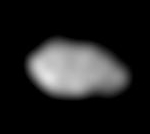
Metis, also known as Jupiter XVI, is the innermost known moon of Jupiter. It was discovered in 1979 in images taken by Voyager 1, and was named in 1983 after the first wife of Zeus, Metis. Additional observations made between early 1996 and September 2003 by the Galileo spacecraft allowed its surface to be imaged.

Atlas is an inner satellite of Saturn which was discovered by Richard Terrile in 1980 from Voyager photos and was designated S/1980 S 28. In 1983 it was officially named after Atlas of Greek mythology, because it "holds the rings on its shoulders" like the Titan Atlas held the sky up above the Earth. It is also designated Saturn XV.

Pan is the innermost named moon of Saturn. It is a small, ravioli-shaped moon approximately 35 kilometres across and 23 km wide that orbits within the Encke Gap in Saturn's A Ring. Pan is a ring shepherd and is responsible for keeping the Encke Gap free of ring particles. It is sometimes described as having the appearance of a walnut.
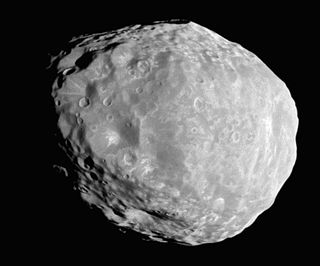
Janus is an inner satellite of Saturn. It is also known as Saturn X. It is named after the mythological Janus. This natural satellite was first identified by Audouin Dollfus on December 15, 1966, although it had been unknowingly photographed earlier by Jean Texereau. Further observations led to the realization that Janus shares a unique orbital relationship with another moon, Epimetheus. The discovery of these two moons' peculiar co-orbital configuration was later confirmed by Voyager 1 in 1980.

Epimetheus is an inner satellite of Saturn. It is also known as Saturn XI. It is named after the mythological Epimetheus, brother of Prometheus.
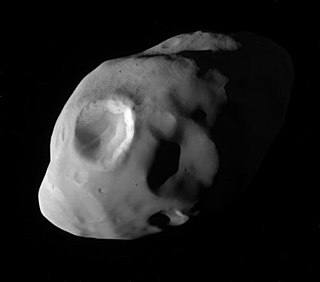
Pandora is an inner satellite of Saturn. It was discovered in 1980 from photos taken by the Voyager 1 probe and was provisionally designated S/1980 S 26. In late 1985, it was officially named after Pandora from Greek mythology. It is also designated as Saturn XVII.

Mimas, also designated Saturn I, is the seventh-largest natural satellite of Saturn. With a mean diameter of 396.4 kilometres or 246.3 miles, Mimas is the smallest astronomical body known to be roughly rounded in shape due to its own gravity. Mimas's low density, 1.15 g/cm3, indicates that it is composed mostly of water ice with only a small amount of rock, and study of Mimas's motion suggests that it may have a liquid ocean beneath its surface ice. The surface of Mimas is heavily cratered and shows little signs of recent geological activity. A notable feature of Mimas's surface is Herschel, one of the largest craters relative to the size of the parent body in the Solar System. Herschel measures 139 kilometres across, about one-third of Mimas's mean diameter, and formed from an extremely energetic impact event. The crater's name is derived from the discoverer of Mimas, William Herschel, in 1789. The moon's presence has created one of the largest 'gaps' in Saturn's ring, named the Cassini Division, due to orbital resonance destabilizing the particles' orbit there.

Prometheus is an inner satellite of Saturn. It was discovered on 24 October 1980 from photos taken by the Voyager 1 probe, and was provisionally designated S/1980 S 27.

The moons of Saturn are numerous and diverse, ranging from tiny moonlets only tens of meters across to the enormous Titan, which is larger than the planet Mercury. There are 146 moons with confirmed orbits, the most of any planet in the solar system. This number does not include the many thousands of moonlets embedded within Saturn's dense rings, nor hundreds of possible kilometer-sized distant moons that were seen through telescopes but not recaptured. Seven Saturnian moons are large enough to have collapsed into a relaxed, ellipsoidal shape, though only one or two of those, Titan and possibly Rhea, are currently in hydrostatic equilibrium. Three moons are particularly notable. Titan is the second-largest moon in the Solar System, with a nitrogen-rich Earth-like atmosphere and a landscape featuring river networks and hydrocarbon lakes. Enceladus emits jets of ice from its south-polar region and is covered in a deep layer of snow. Iapetus has contrasting black and white hemispheres as well as an extensive ridge of equatorial mountains among the tallest in the solar system.

Pallene is a very small natural satellite of Saturn. It is one of three small moons known as the Alkyonides that lie between the orbits of the larger Mimas and Enceladus. It is also designated Saturn XXXIII.

The rings of Saturn are the most extensive and complex ring system of any planet in the Solar System. They consist of countless small particles, ranging in size from micrometers to meters, that orbit around Saturn. The ring particles are made almost entirely of water ice, with a trace component of rocky material. There is still no consensus as to their mechanism of formation. Although theoretical models indicated that the rings were likely to have formed early in the Solar System's history, newer data from Cassini suggested they formed relatively late.
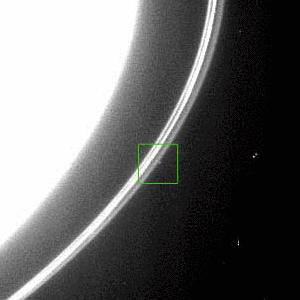
S/2004 S 3 is the provisional designation of an object seen orbiting Saturn just beyond the outer strand of the F ring on June 21, 2004. It was discovered by the Cassini Imaging Science Team in images taken by the Cassini–Huygens probe on June 21, 2004 and announced on September 9, 2004.

The planet Jupiter has a system of faint planetary rings. The Jovian rings were the third ring system to be discovered in the Solar System, after those of Saturn and Uranus. The main ring was discovered in 1979 by the Voyager 1 space probe and the system was more thoroughly investigated in the 1990s by the Galileo orbiter. The main ring has also been observed by the Hubble Space Telescope and from Earth for several years. Ground-based observation of the rings requires the largest available telescopes.

Polydeuces, also designated Saturn XXXIV, is a small trojan moon of Saturn occupying the trailing L5 Lagrange point of Dione. It was discovered by the Cassini Imaging Science Team in images taken by the Cassini space probe on 21 October 2004. With a mean diameter of about 3 km (1.9 mi), Polydeuces is thought to have a smooth surface coated with fine, icy particles accumulated from the cryovolcanic plumes of Enceladus. In its orbit around Saturn, Polydeuces periodically drifts away from Dione's Lagrange point due to gravitational perturbations by other nearby moons of Saturn. Of the four known trojan moons of Saturn, Polydeuces exhibits the largest displacement from its Lagrange point.
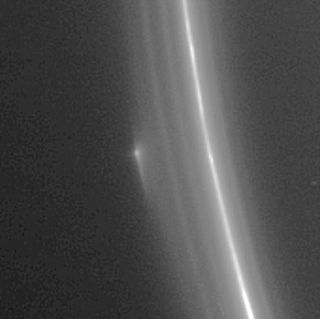
S/2004 S 6 is the provisional designation of a dusty object seen orbiting Saturn very close to the F ring. It is not clear whether it is only a transient clump of dust, or if there is a solid moonlet at its core.

Carolyn C. Porco is an American planetary scientist who explores the outer Solar System, beginning with her imaging work on the Voyager missions to Jupiter, Saturn, Uranus and Neptune in the 1980s. She led the imaging science team on the Cassini mission in orbit around Saturn. She is an expert on planetary rings and the Saturnian moon, Enceladus.
In astronomy, an inner moon or inner natural satellite is a natural satellite following a prograde, low-inclination orbit inwards of the large satellites of the parent planet. They are generally thought to have been formed in situ at the same time as the coalescence of the original planet. Neptune's moons are an exception, as they are likely reaggregates of the pieces of the original bodies, which were disrupted after the capture of the large moon Triton. Inner satellites are distinguished from other regular satellites by their proximity to the parent planet, their short orbital periods, their low mass, small size, and irregular shapes.
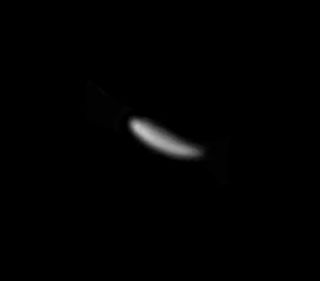
Aegaeon, or Saturn LIII, is a natural satellite of Saturn. It has an extremely elongated shape whose surface is thought to be similarly smooth as Methone. It orbits between Janus and Mimas within Saturn's G Ring.

S/2009 S 1 is a moonlet embedded in the outer part of Saturn's B Ring, orbiting 117,000 km (73,000 mi) away from the planet. The moonlet was discovered by the Cassini Imaging Team during the Saturnian equinox event on 26 July 2009, when the Cassini spacecraft imaged the moonlet casting a 36 km (22 mi)-long shadow onto the B Ring. With a diameter of 300 m (1,000 ft), it is most likely a long-lived solid body, which would count it as the smallest and innermost known moon of Saturn.
S/2004 S 4 is the provisional designation of an unconfirmed object seen orbiting Saturn within the inner strand of the F ring on June 21, 2004. It was spotted while J. N. Spitale was trying to confirm the orbit of another provisional object, S/2004 S 3, that was seen 5 hours earlier just exterior to the F ring. The announcement was made on September 9, 2004.




















